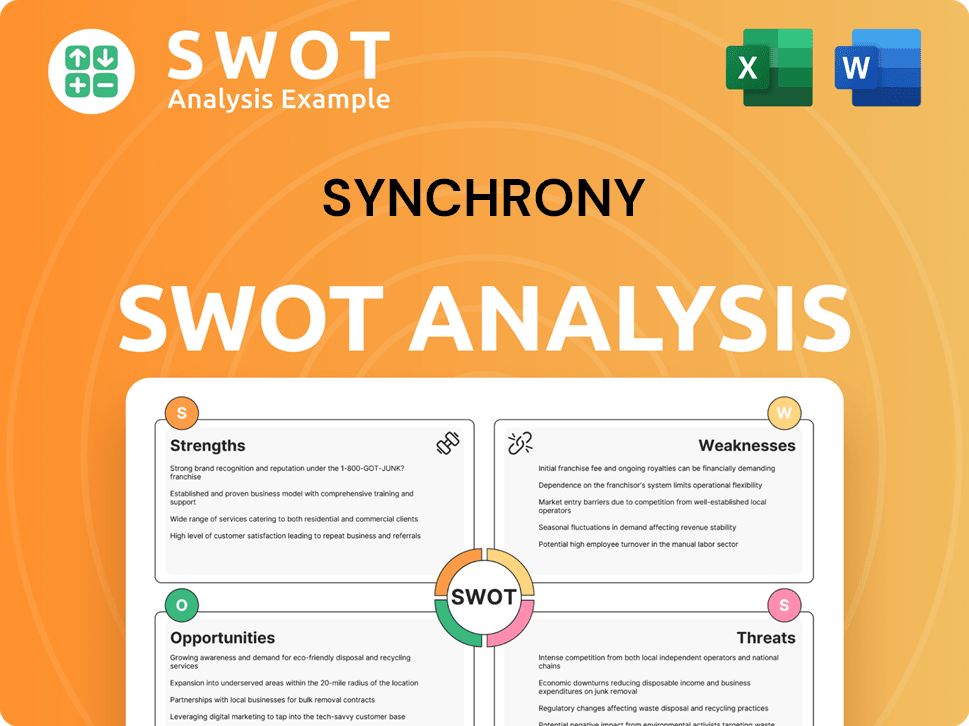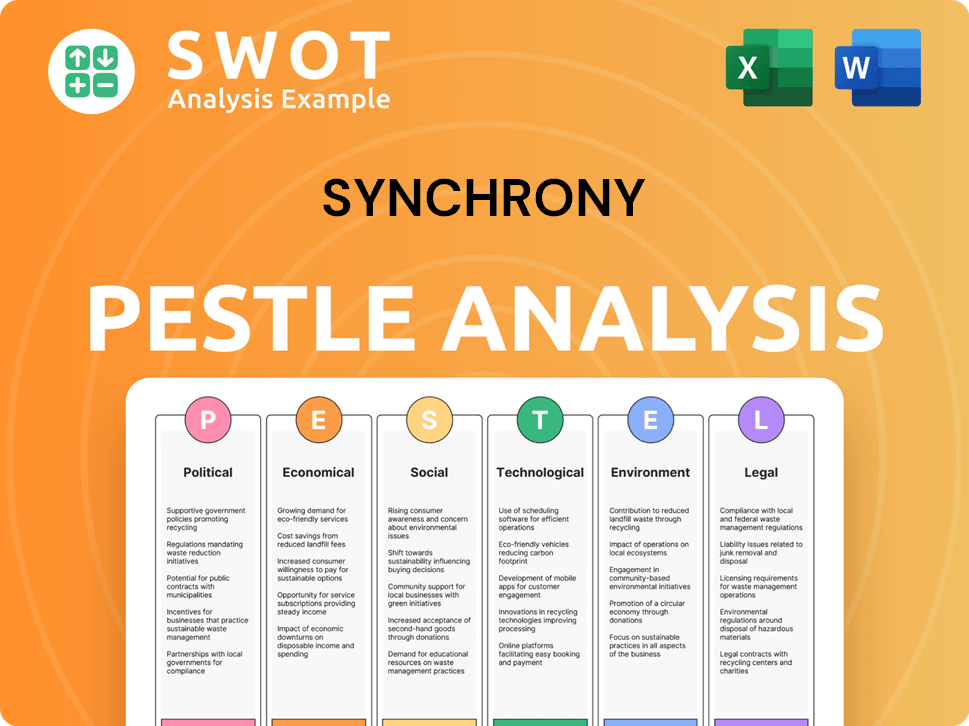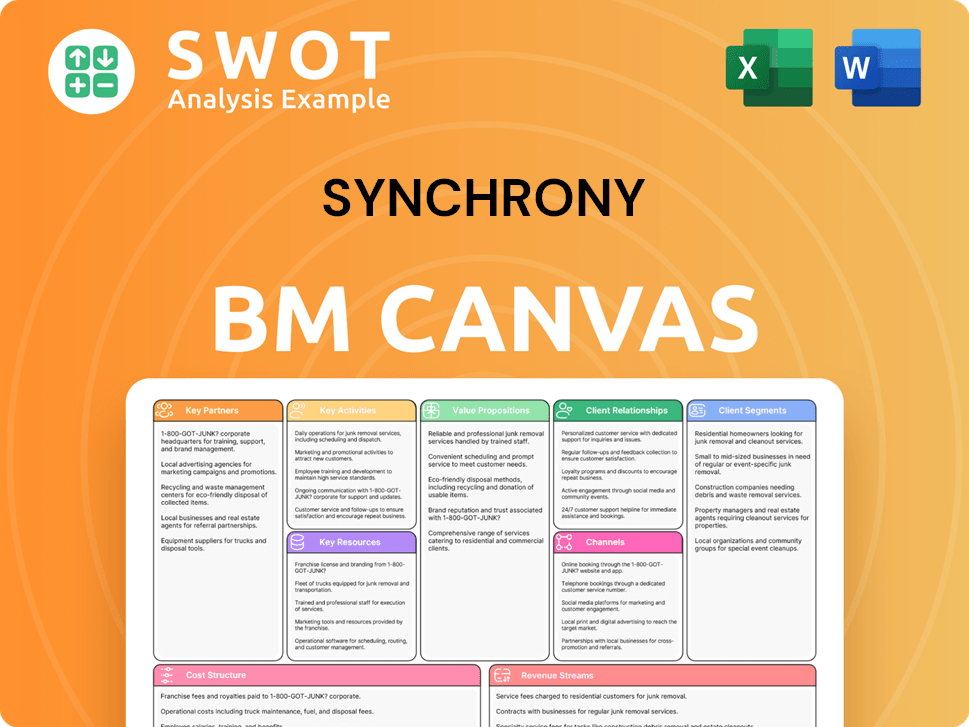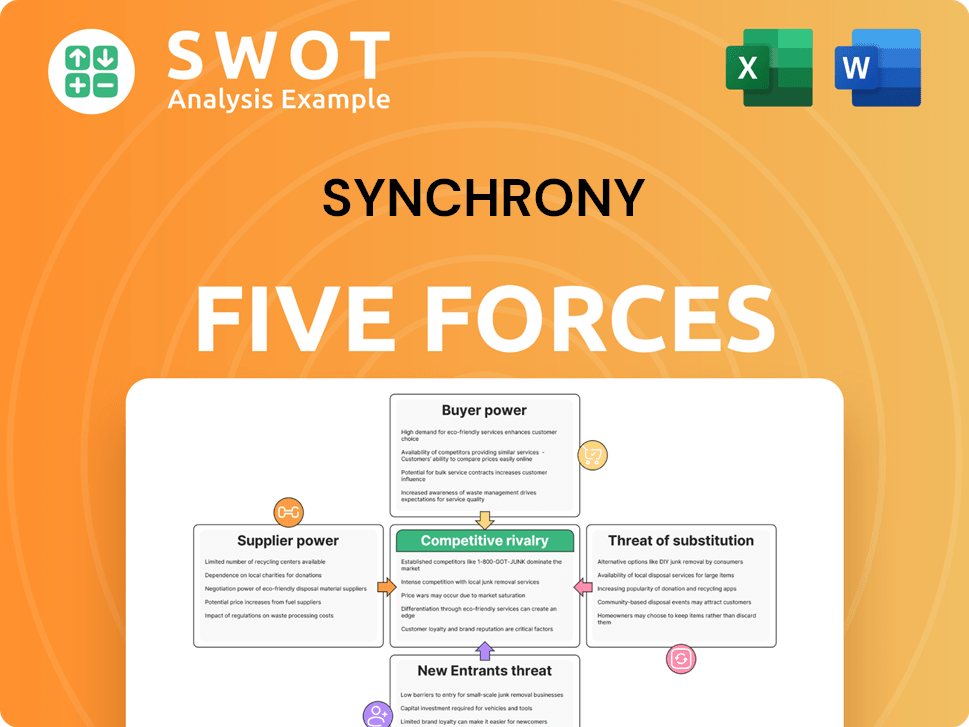Synchrony Bundle
Who Really Owns Synchrony Financial?
Ever wondered who pulls the strings at one of the leading Synchrony SWOT Analysis in the financial services industry? Synchrony Financial, a major credit card issuer, has a fascinating ownership story. From its roots within General Electric to its current status as a publicly traded company, understanding its ownership structure is key to grasping its strategic direction. This exploration unveils the key players and their influence.

The evolution of Synchrony's Company Ownership is a compelling narrative of corporate transformation. Synchrony Bank's shift from a subsidiary to an independent entity has profoundly impacted its operations and market position. As a major player in the financial services sector, understanding the ownership dynamics of Synchrony Financial is crucial for investors and anyone interested in the credit card issuer's future. This analysis will provide valuable insights into the forces shaping Synchrony.
Who Founded Synchrony?
The story of Synchrony Financial's inception differs from that of many companies. Instead of individual founders, its roots lie within General Electric (GE). The company emerged in 2003 as GE Consumer Finance, a division of the larger conglomerate.
Therefore, the concept of individual founders with specific equity splits at the beginning does not directly apply. Early ownership was entirely held by GE. This structure meant that GE and its shareholders indirectly owned the financial services arm.
GE Consumer Finance was a strategic business unit within GE, leveraging the parent company's financial resources and operational expertise. There were no initial angel investors or early-stage backers acquiring stakes during this phase, as it operated internally. Agreements like vesting schedules or buy-sell clauses were not applicable because it was under GE's corporate umbrella.
GE Consumer Finance was established as a division within GE.
Early ownership was entirely held by General Electric and its shareholders.
The founding vision was from GE's leadership, to expand financial services.
It operated as a strategic business unit, using GE's resources.
Agreements common in startups were not applicable due to its internal structure.
Any disputes would have been internal strategic decisions within GE.
The leadership of GE at the time set the founding 'vision', aiming to expand its financial services offerings. This expansion was designed to capitalize on the increasing demand for consumer credit solutions. The strategic decisions about the allocation of resources and focus for its various divisions were internal to GE. If you're interested in learning more about Synchrony Financial, you can read this article about the company.
Early ownership of Synchrony Financial, then GE Consumer Finance, was entirely within General Electric.
- No individual founders in the traditional sense.
- Early backers were GE and its shareholders.
- No external investors or early-stage backers.
- Operated under GE's corporate structure.
- The founding vision came from GE's leadership.
Synchrony SWOT Analysis
- Complete SWOT Breakdown
- Fully Customizable
- Editable in Excel & Word
- Professional Formatting
- Investor-Ready Format

How Has Synchrony’s Ownership Changed Over Time?
The ownership structure of Synchrony Financial has significantly evolved since its inception. The most pivotal event was its spin-off from General Electric (GE). This transition, completed on July 31, 2014, through an Initial Public Offering (IPO) on the New York Stock Exchange under the ticker 'SYF,' marked its debut as an independent, publicly traded entity. Initially, GE maintained a considerable stake, gradually reducing its ownership over time.
Post-IPO, Synchrony's ownership transitioned towards a more diversified model. Institutional investors now hold the majority of shares. This shift has fundamentally altered Synchrony's governance, making it more responsive to the broader public market and the interests of its diverse shareholder base, while also subjecting it to increased scrutiny and regulatory requirements typical of public entities.
| Key Event | Date | Impact on Ownership |
|---|---|---|
| Spin-off from GE | July 31, 2014 | Initial Public Offering (IPO); transition to independent, publicly traded company. |
| GE's Share Divestiture | 2014-Ongoing | Gradual reduction of GE's ownership stake, increasing public float. |
| Institutional Investment | Post-IPO | Dominance of institutional investors, including asset management firms and mutual funds. |
As of early 2025, major stakeholders in Synchrony Financial include large asset management firms. Vanguard Group Inc., BlackRock Inc., and State Street Corp. are consistently among the top institutional holders, reflecting their broad market index and passively managed fund strategies. These firms collectively hold substantial percentages of Synchrony's outstanding shares, often exceeding 5% each, as detailed in their latest SEC filings. Individual insiders, including Synchrony's executives and board members, also hold shares, though their collective ownership is a relatively small percentage compared to institutional holdings.
The ownership of Synchrony has shifted significantly since its IPO. Institutional investors now hold the majority of shares, with firms like Vanguard and BlackRock as key stakeholders. This shift reflects a move towards a more diversified and publicly-held structure.
- Spin-off from General Electric in 2014.
- Gradual divestiture of GE's stake post-IPO.
- Dominance of institutional investors in current ownership.
- Increased scrutiny and regulatory requirements as a public entity.
Synchrony PESTLE Analysis
- Covers All 6 PESTLE Categories
- No Research Needed – Save Hours of Work
- Built by Experts, Trusted by Consultants
- Instant Download, Ready to Use
- 100% Editable, Fully Customizable

Who Sits on Synchrony’s Board?
The Board of Directors at Synchrony Financial, as of early 2025, oversees the company's strategic direction and ensures accountability to its shareholders. The board typically includes a mix of independent directors and executive directors, with the CEO often serving on the board. Independent directors usually form a majority, promoting objective oversight and reducing potential conflicts of interest. The composition of the board can change, but its primary function remains the same: to represent the interests of all shareholders and ensure sound corporate governance. The board's decisions are regularly scrutinized by proxy advisory firms and institutional investors.
Major shareholders, such as institutional investors like Vanguard and BlackRock, do not typically have direct representatives on the board. However, these large shareholders wield significant influence through their voting power during annual shareholder meetings. These meetings cover critical issues, including director elections and executive compensation. The board's structure and decisions are crucial for maintaining investor confidence and ensuring the company's long-term success. For example, the board's decisions on executive compensation are often a key focus for shareholders, especially in the financial services sector.
| Director Name | Title | Board Committee |
|---|---|---|
| Margaret M. Keane | Executive Chair | N/A |
| Brian D. Doubles | President and Chief Executive Officer | N/A |
| William J. Amelio | Independent Director | Compensation and Management Development Committee |
Synchrony operates under a one-share-one-vote structure, which means that each share of common stock grants its holder one vote on all shareholder matters. This structure ensures a fair distribution of voting power among all shareholders, promoting equitable corporate governance. There are no known dual-class shares or special voting rights that would give disproportionate control to any individual or entity. While there haven't been recent proxy battles that have dramatically reshaped the company's decision-making, the potential for such events always exists. The company's commitment to shareholder democracy is a key aspect of its corporate strategy. To understand more about the company's growth, you can read about the Growth Strategy of Synchrony.
Shareholders vote on key decisions, including director elections and executive compensation. Institutional investors have significant influence through their voting power.
- One-share-one-vote structure ensures equitable voting.
- Board composition is crucial for investor confidence.
- Proxy advisory firms and investors scrutinize board decisions.
- Regular shareholder meetings are a platform for influence.
Synchrony Business Model Canvas
- Complete 9-Block Business Model Canvas
- Effortlessly Communicate Your Business Strategy
- Investor-Ready BMC Format
- 100% Editable and Customizable
- Clear and Structured Layout

What Recent Changes Have Shaped Synchrony’s Ownership Landscape?
Over the past few years, the ownership profile of Synchrony Financial has remained relatively stable, reflecting trends common in the financial services sector. Institutional investors continue to hold a significant portion of the company's shares. While exact percentages fluctuate, major asset managers have consistently maintained their positions. There have been no major shifts in ownership due to share buybacks or secondary offerings, though routine share repurchase programs are common for publicly traded companies.
Industry-wide trends, such as the growth of passive investing through index funds and ETFs, have likely contributed to the stability of institutional ownership in Synchrony Bank. Since its origins as a division of GE, founder dilution isn't a factor. The company's focus remains on operational performance, strategic partnerships, and capital allocation. The expectation is that the ownership structure will continue to be predominantly institutional, with a focus on delivering consistent returns to its shareholder base. To learn more about the company's origins, you can read the Brief History of Synchrony.
| Metric | Details | Data Source (Approximate) |
|---|---|---|
| Institutional Ownership | Typically above 70% | Recent SEC Filings, Q1 2024 |
| Top Institutional Holders | Vanguard, BlackRock, State Street | SEC Filings, Q1 2024 |
| Share Repurchase Programs | Ongoing, amount varies | Company Earnings Reports, 2023-2024 |
The financial services industry is constantly evolving. Synchrony, as a leading credit card issuer, is subject to these changes. Investors should monitor the company's filings and reports for any significant ownership shifts or strategic developments. The company's performance and partnerships are key factors influencing investor sentiment and the stability of its ownership structure.
Institutional ownership has remained a dominant feature of Synchrony Financial's shareholder base. This stability is a common characteristic among established financial institutions. It suggests a level of confidence from large investors in the company's long-term strategy and performance.
Synchrony often uses share repurchase programs to manage capital. These programs can positively impact shareholder value by reducing the number of outstanding shares. The frequency and size of these repurchases can vary depending on the company's financial performance and market conditions.
The rise of passive investing, through index funds and ETFs, has likely contributed to the stability of Synchrony's institutional ownership. These funds often include Synchrony Financial in their portfolios, providing a consistent demand for the company's shares.
The ownership structure of Synchrony is expected to remain largely institutional. Key factors to watch include the company's financial performance, strategic partnerships, and any potential changes in the regulatory environment. These factors will influence investor confidence and the stability of the company's ownership.
Synchrony Porter's Five Forces Analysis
- Covers All 5 Competitive Forces in Detail
- Structured for Consultants, Students, and Founders
- 100% Editable in Microsoft Word & Excel
- Instant Digital Download – Use Immediately
- Compatible with Mac & PC – Fully Unlocked

Related Blogs
- What are Mission Vision & Core Values of Synchrony Company?
- What is Competitive Landscape of Synchrony Company?
- What is Growth Strategy and Future Prospects of Synchrony Company?
- How Does Synchrony Company Work?
- What is Sales and Marketing Strategy of Synchrony Company?
- What is Brief History of Synchrony Company?
- What is Customer Demographics and Target Market of Synchrony Company?
Disclaimer
All information, articles, and product details provided on this website are for general informational and educational purposes only. We do not claim any ownership over, nor do we intend to infringe upon, any trademarks, copyrights, logos, brand names, or other intellectual property mentioned or depicted on this site. Such intellectual property remains the property of its respective owners, and any references here are made solely for identification or informational purposes, without implying any affiliation, endorsement, or partnership.
We make no representations or warranties, express or implied, regarding the accuracy, completeness, or suitability of any content or products presented. Nothing on this website should be construed as legal, tax, investment, financial, medical, or other professional advice. In addition, no part of this site—including articles or product references—constitutes a solicitation, recommendation, endorsement, advertisement, or offer to buy or sell any securities, franchises, or other financial instruments, particularly in jurisdictions where such activity would be unlawful.
All content is of a general nature and may not address the specific circumstances of any individual or entity. It is not a substitute for professional advice or services. Any actions you take based on the information provided here are strictly at your own risk. You accept full responsibility for any decisions or outcomes arising from your use of this website and agree to release us from any liability in connection with your use of, or reliance upon, the content or products found herein.